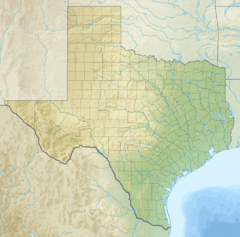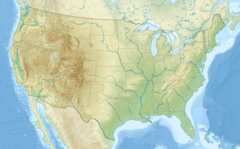Tongue River (Texas) facts for kids
Quick facts for kids Tongue River |
|
|---|---|
| Country | United States |
| Physical characteristics | |
| Main source | Texas 33°50′59″N 100°56′34″W / 33.8498027°N 100.9426396°W |
| River mouth | 34°07′35″N 100°24′06″W / 34.1264624°N 100.4017842°W |
The Tongue River is a river located in the state of Texas, in the United States. It is an important part of the natural landscape in the area. This river eventually flows into a larger river system, playing a role in the water cycle of the region.
Contents
Discover the Tongue River in Texas
The Tongue River is a natural waterway found in the northern part of Texas. It begins in one area and flows across the land, eventually joining another, bigger river. Understanding where rivers start and end helps us learn about the geography of a place.
Where Does the Tongue River Start and End?
The Tongue River begins its journey in Texas. Its starting point is known as its source. From there, the river flows generally eastward. It travels through different landscapes as it makes its way across the state.
The Tongue River does not flow directly into the ocean. Instead, it is a tributary. This means it flows into another, larger river. The Tongue River joins the Red River of the South. The place where a smaller river meets a larger one is called its mouth or confluence.
What is a River System?
A river system includes a main river and all the smaller rivers and streams that flow into it. These smaller waterways are called tributaries. The Tongue River is a tributary of the Red River of the South. This means it is part of a much larger network of water.
- The Red River of the South is a major river in the southern United States.
- It forms part of the border between Texas and Oklahoma.
- Many smaller rivers, like the Tongue River, contribute water to it.
Why Are Rivers Important?
Rivers like the Tongue River are very important for many reasons. They are not just lines on a map. They are vital parts of our environment and support life.
Rivers and Nature
Rivers provide homes for many plants and animals. Fish, insects, birds, and mammals all depend on rivers for water, food, and shelter. The areas around rivers, called riparian zones, are often very rich in wildlife.
- Rivers help keep the land fertile.
- They carry nutrients that help plants grow.
- They create unique habitats for different species.
Rivers and People
For centuries, people have lived near rivers. Rivers provide fresh water for drinking, farming, and industry. They have also been used for transportation, allowing people to travel and trade goods.
- Rivers are a source of fresh water for communities.
- They can be used for recreation, like fishing or boating.
- Rivers help shape the land and influence where towns are built.
Exploring Texas Rivers
Texas has many rivers and streams that crisscross the state. Each river, including the Tongue River, plays a unique role in the state's geography and environment. Learning about these rivers helps us understand the natural world around us.



